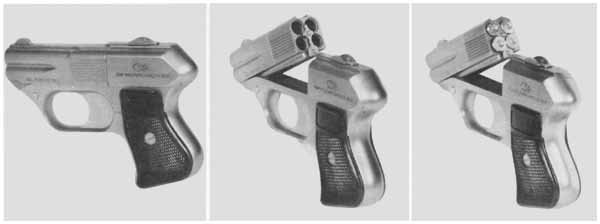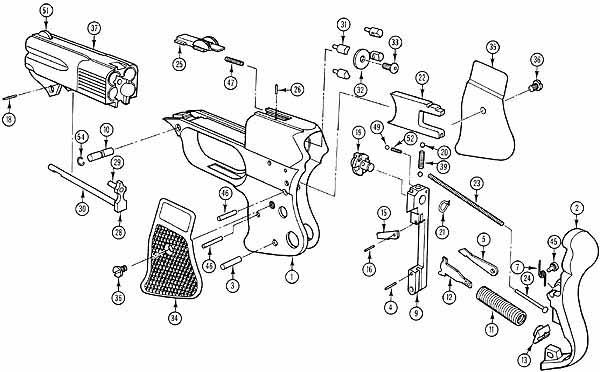Leon's Gun:
Mother's Defender
The
COP .357 Magnum
By
Phil Steinschneider
Introduction
Holden: The tortoise lays on its
back, its belly baking in the hot sun beating its legs trying to turn itself
over but it can't, not without your help, but you're not helping.
Leon: What do you mean I'm not
helping?
Holden: I mean you're not helping.
Why is that Leon?
They're just questions, Leon. In
answer to your query, they're written down for me. It's a test, designed to
provoke an emotional response.
Shall we continue? Describe in
single words, only the good things that come in to your mind about.. your mother.
Leon: My mother?
Holden: Yeah.
Leon: Let me tell you about my
mother…BLAM
These are the unforgettable lines that introduce us to Leon's gun in the classic
science fiction movie Blade Runner. Unfortunately, and for unknown reasons,
the armaments in Blade Runner have almost never officially been discussed.
Instead, a cult following has evolved around the movie's props and weaponry (as
well as the film itself). Hopefully, this article will clarify many questions
about what has until now been a very mysterious prop - Leon's gun.
Assistant
Art Director Stephen Dane produced several preliminary sketches during pre-production
of a gun that Deckard (Harrison Ford) was to use throughout the movie. The
drawings all appear to depict a COP .357 or a derivation of it. In the end,
probably at the direction of Ridley Scott, the COP was dropped as the gun to be
used by Rick Deckard. Instead, the COP, in completely unaltered form, was
employed as the weapon Leon uses to maim the Blade Runner Holden in the famous
opening scene of the film (see fig. 1).

fig. 1
History
and Critique
The
now defunct COP Inc. of Torrance, California, originally produced the COP, or
Compact Off-Duty Police. Here is an excerpt from the user manual describing the
purpose behind the gun's commercial manufacture:
"The COP was specifically
designed as a police off-duty or back-up handgun. It combines the flatness of
the automatic with the instant readiness of the revolver. Many special features
not available in any other handgun are built into the COP to make it a highly
specialized personal defense weapon."
A
fascinating weapon in appearance, the COP has some very interesting
features: First, it provides the ability to fire four quick, successive shots.
Second, it can safely be carried in the loaded and firing position with almost
no chance of accidental discharge due to its very hard trigger pull. Third, it
is virtually indestructible because of its stainless steel manufacture.
Nevertheless, some of the COP's primary features also act as some of its major
distractions. The trigger pull, as mentioned earlier, is extremely long and hard.
Furthermore, the weapon's stainless steel construction makes it a small but
relatively heavy weapon to carry. At a hefty 28 oz. unloaded, the COP is
certainly very noticeable when it is strapped to your calf or other back-up
weapon location.
Functionality
The
COP has a very interesting and unusual firing mechanism. The weapon is loaded by
releasing a catch on the top of the pistol and tilting down the four barrels,
which pivot on a pin inserted through the frame, to expose the breech. Once
open, four bullets can be placed into the available chambers. One then reengages
the barrel into the frame until a click is heard. The gun is now ready to fire.
As the trigger is pulled, an internal ratchet is actuated that lines up to a
cocking hammer and one of the four firing pins. After the trigger has traveled
to the end of its stroke, the internal hammer is released, exerting force on the
ratchet which in turn pushes one of the firing pins forward, igniting the
primer, and firing the bullet. Each subsequent pull of the trigger causes the
ratchet to line up with the next firing pin in the sequence and firing the
bullet in that chamber, until the gun is out of ammunition or the shooter stops
pulling the trigger (see fig. 2).

fig. 2
Made
entirely of stainless steel, except for the grips, which are made of checkered wood, the
COP is comprised of over 50 separate parts (see fig. 3). Although the gun can be
taken apart, it is not easily field stripped and requires that one screw and
several pins be removed for disassembly.

| 1. |
Frame |
| 2. |
Backstrap |
|
3. |
Mounting Pin |
|
4. |
Hammer Strut
Bearing Pin |
|
5. |
Hand |
|
7. |
Hand Spring |
| 9. |
Hammer |
| 10. |
Barrel Pin |
| 11. |
Hammer Spring |
| 12. |
Strut |
| 13. |
Bearing |
| 15. |
Sear |
| 16. |
Sear Pin |
| 18. |
Extractor Stop
Pin |
|
|
|
| 19. |
Ratchet |
|
20. |
Ratchet Plunger
(2) |
|
21. |
Ratchet
Retaining Ring |
|
22. |
Trigger |
|
23. |
Trigger Spring |
|
24. |
Trigger Spring
Guide Rod |
|
25. |
Latch |
|
26. |
Latch Stop Pin |
|
28. |
Extractor |
|
29. |
Extractor Guide |
|
30. |
Extractor Push
Rod |
|
31. |
Firing Pin (4) |
|
32. |
Firing Pin
Washer Retaining Screw |
|
|
|
| 33. |
Firing Pin
Retaining Screw |
| 34. |
Left Grip |
| 35. |
Right Grip |
| 36. |
Grip Screw |
| 37. |
Barrel |
| 39. |
Ratchet Plunger
Spring |
| 45. |
Hand Pivot Pin |
| 46. |
Hand Pivot &
Mounting Pin (2) |
| 47. |
Latch Spring |
| 49. |
Ratchet Retainer
Ball |
| 51. |
Front Sight |
| 52. |
Ratchet Bal
Springl |
| 54. |
Pivot Pin
Retaining Ring |
|
|
|
fig. 3
Specifications
| Caliber |
38
special & .357 Magnum |
| Number of Shots |
4 |
| Construction |
All
Stainless Steel |
| Length |
5.6
inches |
| Width |
1.062
inches |
|
| Height |
4.1
inches |
| Weight empty |
28
oz. |
| Finish |
Semi-matte |
| Type of Action |
Double |
| |
|
|
In
the Movie
No
one describes the gun used by the replicant Leon Kowalski better than the man
who played him in Blade Runner, recently deceased Brion James:
"The gun I fired at
Holden was real weapon that's made in Compton, California. It looks space-age,
but it's real. And it has four barrels on it. That way you can shoot four shots
one right after the other; it's sort of like a quadruple-barrel gun."
Excellent
background information is available on Leon's gun and its creation, as well as
the above quote from Mr. James, in Paul Sammon's book Future Noir: The Making
of Blade Runner on pages 109 and 239.
Additionally, there is one important detail
which will now be revealed for the first time: According to Art Shippee, Jr., the property
master responsible for the weapons in the movie, the COP .357 used in Blade Runner had been altered to
fire two barrels simultaneously. This modification helped create the greater
than expected flash that is visible in the movie (see fig. 4).

fig. 4
Price and Availability
The
COP .357 has been out of production for many years and is relatively difficult
to locate. Nevertheless, with a little luck, good examples of COPs can still be
found and purchased for a reasonable price. According to the fourteenth edition
of the Blue Book of Gun Values, depending on condition, a COP should
retail for between $200 and $350 with $200 representing a gun in 60% condition
and $350 being the price for a pistol in 100% or mint condition. The following
places are excellent sources for those looking to acquire a COP handgun:
The
Gun List
The Shotgun News
www.gunsamerica.com
It has been this author's experience that although the suggested price for a
mint COP is $350, in general, the usual cost for a NIB (New In Box) version will
run as high as $495 to $550.
COP
Prop Reproductions
There is anecdotal evidence that some replicas of the COP have been
produced by the Japanese. Although this has never been confirmed, this author
recently stumbled upon photographs of what appear to be replicas of a Stephan
Dane design prototype and the COP pistol in Spinner Dokuhon Final Plus 44 (see fig.
5).

fig. 5
The
COP Used in the Movie
The
actual COP used in the movie Blade Runner was supplied by the legendary but now
bankrupt Sembridge Gun Rentals, Inc. of Los Angles, California. For many years
Stembridge was Hollywood's supplier of choice for movie weapons.
Unfortunately, due to the increasing number of productions going to Canada and
overseas, Stembridge was forced to close their doors in the middle of 1999.
According to a representative, a very wealthy individual purchased the entire
collection, including Leon's gun from Blade Runner.
The
Blade Runner COP pistol is well documented and will probably show up at a
Christie's or Sotheby's auction one day. However, if you accidentally stumble on
a COP .357 that has been legally altered to fire two barrels at once, you may
have found the original COP used during the filming of Blade Runner.
In
Conclusion
Blade Runner has been a science fiction fan favorite for many years. Since
the release of the Director's Cut in 1992 the Blade Runner cult has grown
immensely. In 1996 Westwood released the Blade Runner game and a new generation
was introduced to the movie's story, concepts, props, and social commentary.
Thanks to its legions of loyal fans, a movie that was unsuccessful during its
original release, is now considered one of the top five science fiction films ever produced.
Hopefully, this article will shed a little light on one of the two mysterious
Blade Runner guns. It is about time that the hand props of this classic film
were given the coverage they deserve.
Additional
Photographs and the Owner's Manual
Click here for additional
"precious" photos. Click
here to download the owner's manual in Adobe Acrobat format (please
be patient as the file is 2.2 Megs in size).
Bibliography
and References
Sammon,
Paul M., Future Noire: The Making of Blade Runner: HarperPaperbacks,
1996.
Fjestad, S.P., Fourteenth Edition Blue Book of Gun Values: Blue Book
Publications, Inc., 1993 - [Online]
http://www.bluebookinc.com.
Spinner Dokuhon Final Plus 44: TVC-15 Publishing, 1999.
The
Blade Runner Sketchbook: Dolphin Publishing, 1982.
Gun List: Krause Publications, Inc., 1999 -- [Online] http://www.Gunlist.net.
Shotgun News: Primedia, 1999 -- [Online] http://www.shotgunnews.com.









